NCERT Solutions for Class 12 Maths Chapter 9 - Differential Equations - Exercise 9.4

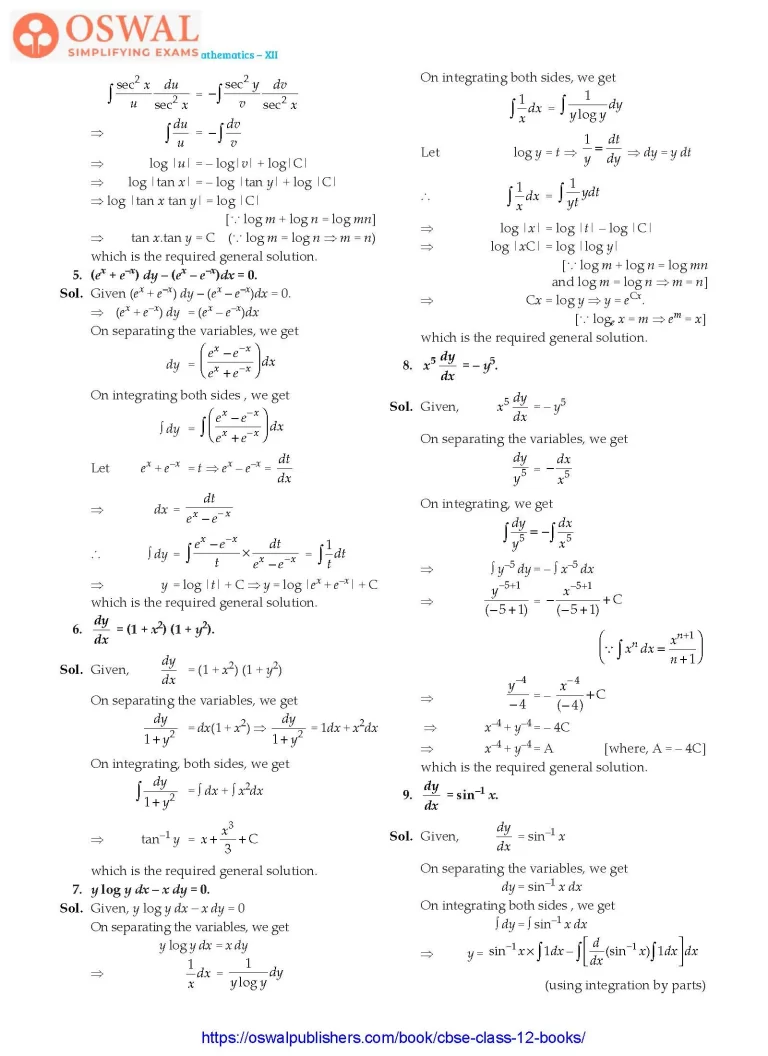

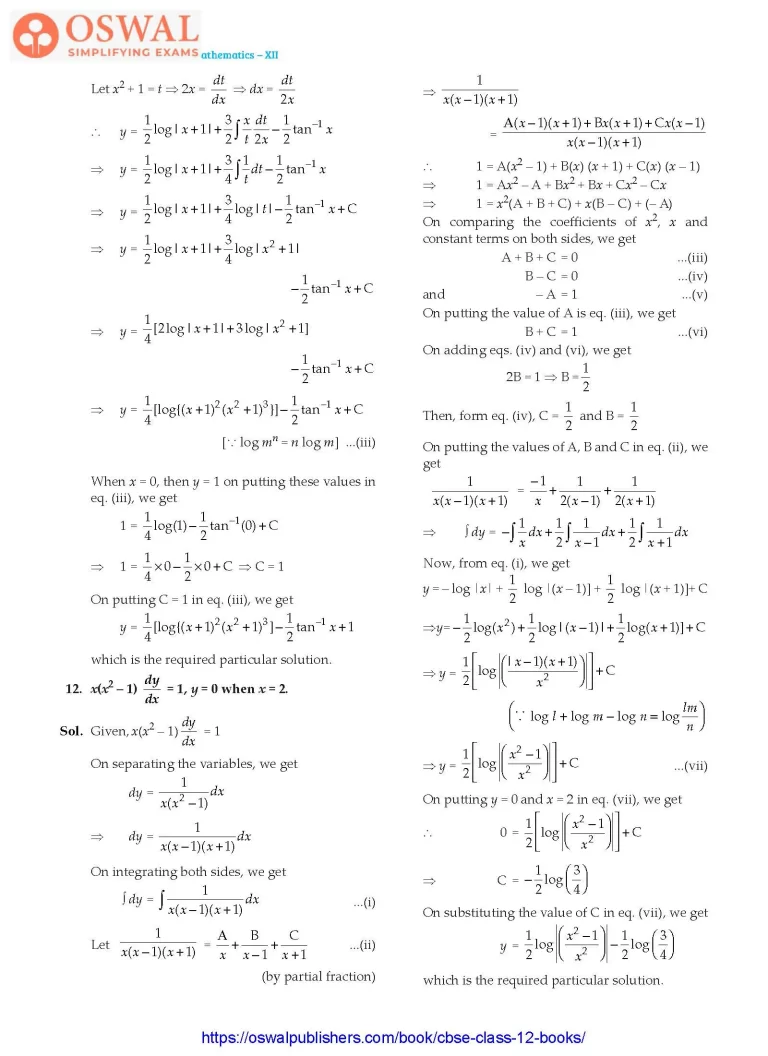
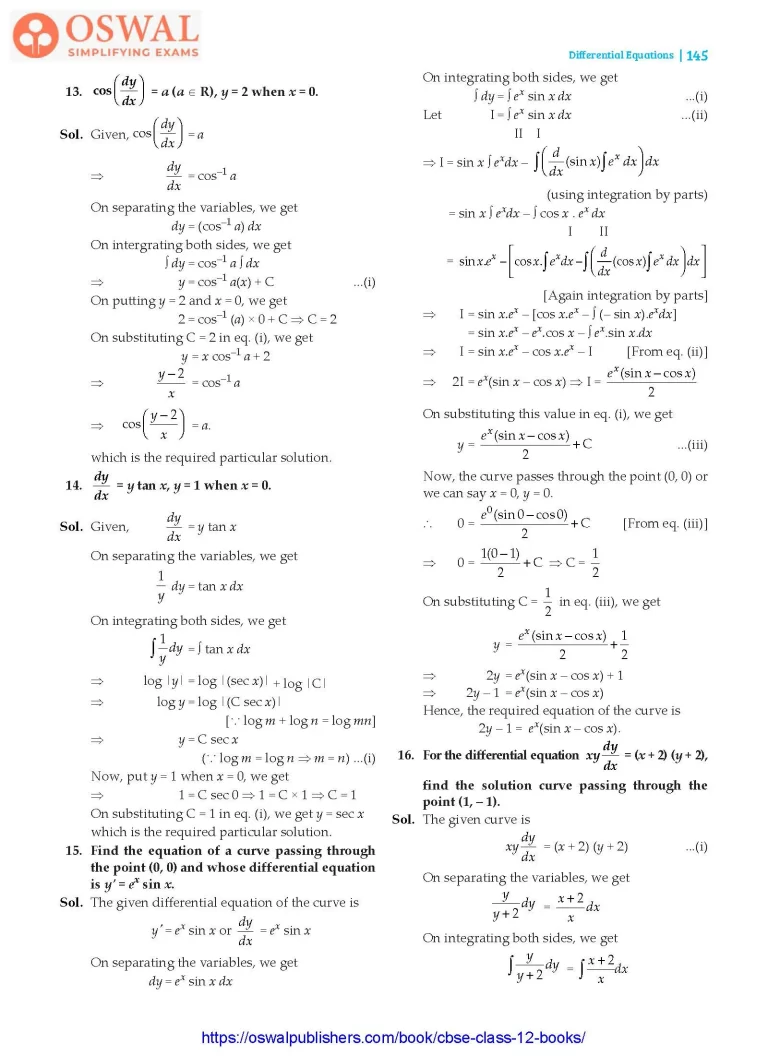
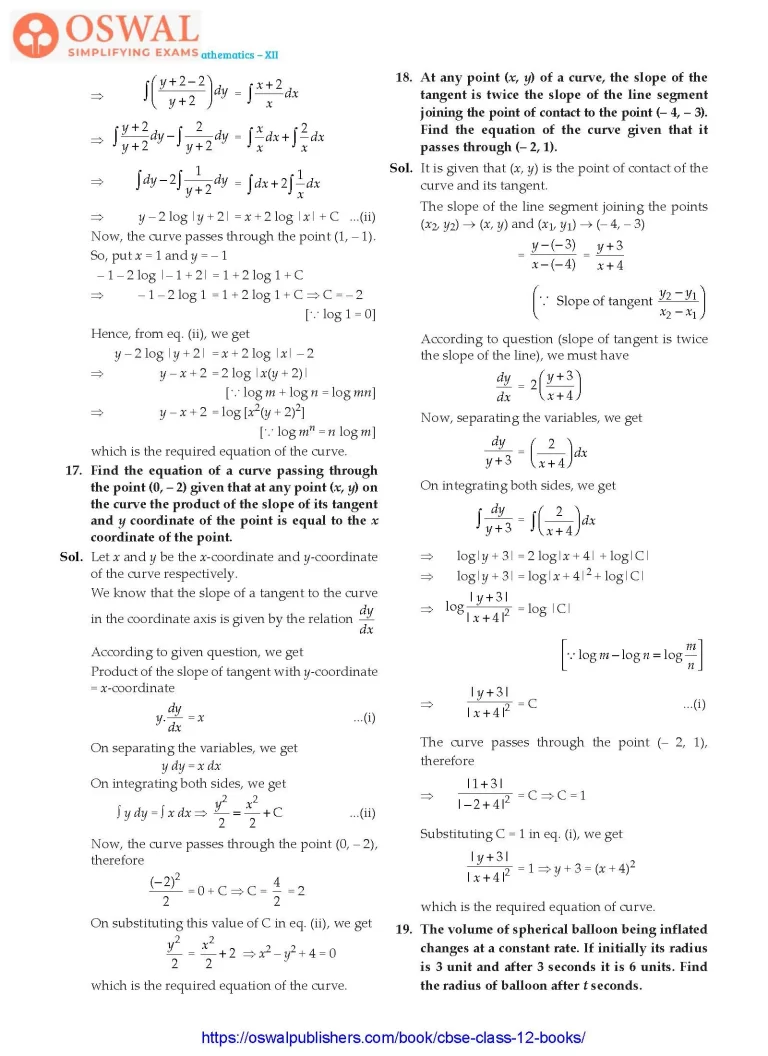
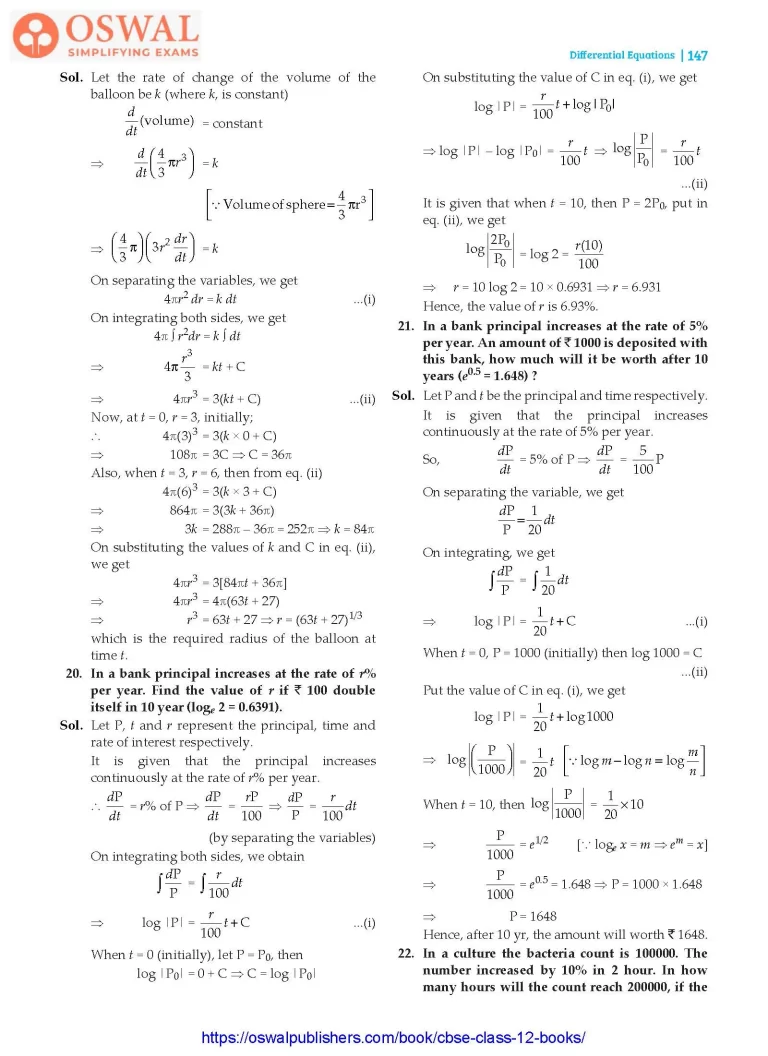
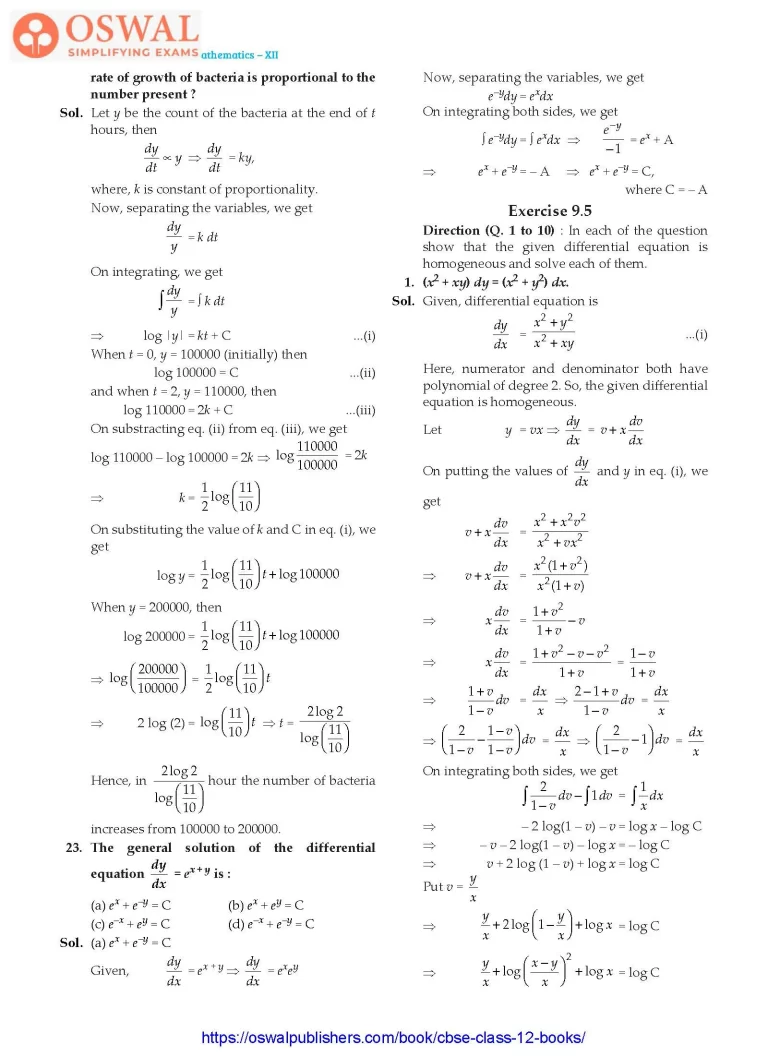
Access Exercises of Class 12 Maths Chapter 9 – Differential Equations
Exercise 9.1 Solutions 12 Questions
Exercise 9.2 Solutions 12 Questions
Exercise 9.3 Solutions 12 Questions
Exercise 9.4 Solutions 23 Questions
Exercise 9.5 Solutions 17 Questions
Exercise 9.6 Solutions 19 Questions
Miscellaneous Exercise on Chapter 9 Solutions 18 Questions
Exercise 9.4
Direction (Q. 1 to 10) : For each of the differential equation in exercises, find the general solution.
$$\textbf{1.\space}\frac{\textbf{dy}}{\textbf{dx}} = \frac{\textbf{1 - cos x}}{\textbf{1 + cos x}}.\\\textbf{Sol.\space}\text{Given}\space\frac{dy}{dx} = \frac{\text{1- cos x}}{\text{1 + cos x}}$$
On separating the variables and integrating, we get
$$\int \text{dy =} \int\frac{\text{1 - cos x}}{\text{1 + cos x}}dx\\\Rarr\space y=\int\frac{2 \space\text{sin}^{2}x(x/2)}{\text{2 cos}^{2}(x/2)}dx\\\lbrack\because\space \text{1 - cos x = 2 sin}^{2}(x/2)\\\text{and}\space \text{1 + cos x = 2 cos}^{2}(x/2)\rbrack\\\Rarr\space y =\int\text{tan}^{2}(x/2)dx\\\bigg(\because\space 1 + \text{tan}^{2}\frac{x}{2} = \text{sec}^{2}\frac{x}{2}\bigg)\\\Rarr\space y = \int(\text{sec}^{2}(x/2)-1)dx\\\Rarr\space y=\int\text{sec}^{2}(x/2)dx - \int 1 dx$$
$$\Rarr\space y = 2\space\text{tan}\frac{x}{2}- x + \text{C.}\\(\because\space \int \text{sec}^{2}x dx = tan x)$$
which is the required general solution.
$$\textbf{2.\space}\frac{\textbf{dy}}{\textbf{dx}} = \sqrt{\textbf{4-y}^{\textbf{2}}}\textbf{(-2} \lt \textbf{y}\lt \textbf{2)}\\\textbf{Sol.\space}\text{Given,\space}\frac{dy}{dx} = \sqrt{4 - y^{2}}$$
On separating the variables, we get
$$\text{dx} = \frac{dy}{\sqrt{4 - y^{2}}}$$
On integrating, we get
$$\int\frac{dy}{\sqrt{2^{2} - y^{2}}} = \int\space dx\\\Rarr\space \text{sin}^{\normalsize-1}\frac{y}{2} = x + \text{C}\\\bigg(\because\space \int\frac{1}{\sqrt{a^{2}-x^{2}}}dx = \text{sin}^{\normalsize-1}\frac{x}{a}\bigg)\\\Rarr\space\frac{y}{2} = \text{sin \space (x+ C)}\\\Rarr\space y = 2\space \text{sin}(x + C)$$
which is the required general solution.
$$\textbf{3.\space}\frac{\textbf{dy}}{\textbf{dx}}\textbf{+ y = 1( y}\neq \textbf{1).}\\\textbf{Sol.\space }\text{Given}\frac{dy}{dx}+y=1$$
On separating the variables, we get
dy + y dx = dx
$$\Rarr\space dy = dx - y dx\\\Rarr\space dy = dx(1-y)\\\Rarr\space dx = \frac{dy}{1-y}$$
On integrating both sides, we get
$$\int\frac{dy}{(1-y)} = \int dx\\\Rarr\space - \text{log}|1-y| \text{= x - C}\\\Rarr\space \text{-x + C = log}|1 - y|\\\Rarr\space |1-y| = e^{\normalsize\text{-x + C}}\\\lbrack\because\space \text{log}_e x = m\Rarr\space e^{m} = x\rbrack\\\Rarr\space y-1 = (\pm e^{C})e^{\normalsize-x}\\\Rarr\space y = 1 + Ae^{\normalsize-x}$$
(where (A = ± eC))
which is the required general solution of the given differential equation.
4. sec2 x tan y dx + sec2 y tan x dy = 0.
Sol. Given, sec2 x tan y dx + sec2 y tan x dy = 0.
On separating the variables, we get
$$\Rarr\space \text{sec}^{2}\text{x tany dx}\\ = - sec^{2}\text{y tan x dx}\\\Rarr\space \frac{\text{sec}^{2}x}{\text{tan x}}dx = -\frac{\text{sec}^{2}y}{\text{tan y}}dy$$
On integrating both sides, we get
$$\int\frac{\text{sec}^{2}x}{\text{tan x}}dx =-\int\frac{\text{sec}^{2}y}{\text{tan y}}dy\\\text{let}\space \text{tan x = u}\\\Rarr\space \text{sec}^{2}x =\frac{du}{dx}\\\Rarr\space dx =\frac{du}{\text{sec}^{2}x}\\\text{and\space tan y = v}\Rarr\text{sec}^{2}y = \frac{dx}{dy}\\\Rarr\space dy = \frac{dv}{\text{sec}^{2}y}\\\int\frac{\text{sec}^{2}x}{u}\frac{du}{\text{sec}^{2}x} = -\int\frac{\text{sec}^{2}y}{v}\frac{dv}{\text{sec}^{2}x}\\\Rarr\space\int\frac{du}{u} = -\int\frac{dv}{v}$$
$$\Rarr\space\text{log}|u| = -\text{log}|v| + \text{log}|\text{C}|\\\Rarr\space\text{log}|\text{tan x}| = -\text{log}|\text{tan y}| + \text{log}|\text{C}|\\\Rarr\space\text{log}|\text{tan x tany}| = \text{log}|\text{C}|\\\lbrack\because\space \text{log m + log n = log mn}\rbrack\\\Rarr\space \text{tan x . tany = C}\\(\because\space \text{log m = log n}\Rarr\space m = n)$$
which is the required general solution.
5. (ex + e–x) dy – (ex – e–x)dx = 0.
Sol. Given (ex + e–x) dy – (ex – e–x)dx = 0.
$$\Rarr\space(e^{x} + e^{\normalsize-x})dy = (e^{x} - e^{\normalsize-x})dx$$
On separating the variables, we get
$$\text{dy =}\bigg(\frac{e^{x} - e^{\normalsize-x}}{e^{x}+e^{\normalsize-x}}\bigg)dx\\\text{Let\space e}^{x} + e^{\normalsize-x} = t\\\Rarr\space e^{x}-e^{\normalsize-x}=\frac{dt}{dx}\\\Rarr\space dx=\frac{dt}{e^{x} - e^{\normalsize-x}}\\\therefore\space\int dy = \int\frac{e^{x} - e^{\normalsize-x}}{t}×\frac{dt}{e^{x} - e^{\normalsize-x}}\\=\int\frac{1}{t}dt$$
$$\Rarr\space y =\text{log}|t|+\text{C}\\\Rarr\space y = \text{log}|e^{x} + e^{\normalsize-x}|+\text{C}$$
which is the required general solution.
$$\textbf{6.\space}\frac{\textbf{dy}}{\textbf{dx}} \textbf{= (1 + x}^{\textbf{2}}\textbf{)(1 + y}^{\textbf{2}}\textbf{).}\\\textbf{Sol.\space}\text{Given,\space}\frac{dy}{dx} = (1+x^{2})(1+y^{2})$$
On separating the variables, we get
$$\frac{dy}{1+y^{2}} = dx(1 + x^{2})\\\Rarr\space \frac{dy}{1 + y^{2}} = 1 dx + x^{2}dx$$
On integrating, both sides, we get
$$\int\frac{dy}{1+y^{2}} = \int dx + \int x^{2}dx\\\Rarr\space \text{tan}^{\normalsize-1}y = x + \frac{x^{3}}{3}+\text{C}$$
which is the required general solution.
7. y log y dx – x dy = 0.
Sol. Given, y log y dx – x dy = 0
On separating the variables, we get
y log y dx = x dy
$$\Rarr\space \frac{1}{x}dx = \frac{1}{\text{y log y}}dy$$
On integrating both sides, we get
$$\int\frac{1}{x}dx = \int\frac{1}{\text{y log y}}dy\\\text{Let\space log y = t}\\\Rarr\frac{1}{y}=\frac{dt}{dy}\Rarr\space dy = y dt\\\therefore\space \int\frac{1}{x}dx = \int\frac{1}{yt}y dt\\\Rarr\space \text{log}|x| = \text{log}|t| - \text{log}|C|\\\Rarr\space\text{log}|\text{x C}| = \text{log}|\text{log y}|\\\lbrack\because \text{log m + log n = log mn}\\\text{and log m = log n}\Rarr\space m = n\rbrack\\\Rarr\space \text{Cx} = \text{log y}\Rarr\space y = e^{\text{Cx}}\\\lbrack\because\space \text{log }_ex =m\Rarr\space e^{m} = x\rbrack$$
which is the required general solution.
$$\textbf{8.\space} \textbf{x}^{\textbf{5}}\frac{\textbf{dy}}{\textbf{dx}} \textbf{= -y}^{\textbf{5}}\textbf{.}\\\textbf{Sol.\space} x^{5}\frac{dy}{dx} = - y^{5}$$
On separating the variables, we get
$$\frac{dy}{y^{5}} = -\frac{dx}{x^{5}}$$
On integrating, we get
$$\int\frac{dy}{y^{5}} = -\int\frac{dx}{x^{5}}\\\Rarr\space \int y^{\normalsize-5}dy = -\int x^{\normalsize-5}dx\\\Rarr\space \frac{y^{-5+1}}{(-5+1)} = -\frac{x^{-5+1}}{(-5+1)}+\text{C}\\\bigg(\because\space \int x^{n}dx = \frac{x^{n+1}}{\text{n+1}}\bigg)\\\Rarr\space \frac{y^{\normalsize-4}}{-4}=-\frac{x^{\normalsize-4}}{(-4)}+\text{C}\\\Rarr\space x^{-4} + y^{\normalsize-4}=\text{-4C}\\\Rarr\space x^{\normalsize-4} + y^{\normalsize-4} = A\\\lbrack\text{where, A = - 4 C}\rbrack$$
which is the required general solution.
$$\textbf{9.\space}\frac{\textbf{dy}}{\textbf{dx}} \textbf{= }\textbf{sin}^{\textbf{-1}}\textbf{x.}\\\textbf{Sol.\space}\text{Given,\space}\frac{dy}{dx} = \text{sin}^{\normalsize-1}x$$
On separating the variables, we get
dy = sin–1 x dx
On integrating both sides , we get
$$\int dy = \int\text{sin}^{\normalsize-1}x\space dx\\\Rarr\space y = \text{sin}^{\normalsize-1}x×\int 1 dx -\\\int\bigg[\frac{d}{dx}(\text{sin}^{\normalsize-1}x)\int 1 dx\bigg]dx$$
(using integration by parts)
$$\Rarr\space \text{y = x sin}^{\normalsize-1}x-\int\bigg[\frac{x}{\sqrt{1-x^{2}}}\bigg]dx\\\text{Let 1-x}^{2}=t\\\Rarr\space - 2x = \frac{dt}{dx}=dx = \frac{dt}{-2x}\\\therefore\space y = x\text{sin}^{\normalsize-1}x + \int\frac{x}{\sqrt{t}}\frac{dt}{2x}\\\Rarr\space y = x\space\text{sin}^{\normalsize-1}x + \frac{1}{2}.\frac{t^{-\frac{1}{2}+1}}{\frac{\normalsize -1}{2}+1}+\text{C}\\\Rarr\space y = x \text{sin}^{\normalsize-1}x+\frac{2}{2}\sqrt{t}+\text{C}\\\Rarr\space y = \text{x sin}^{\normalsize-1} x +\sqrt{1-x^{2}}+\text{C}$$
which is the required general solution.
10. ex tan y dx + (1 – ex) sec2 y dy = 0.
Sol. ex tan y dx + (1 – ex) sec2 y dy = 0
On separating the variables, we get
ex tan y dx = – (1 – ex) sec2 y dy
$$\Rarr\space\frac{e^{x}}{(e^{x}-1)}dx = \frac{\text{sec}^{2}y}{\text{tan y}}dy\\\text{Let \space e}^{x}-1=t\\\Rarr\space e^{x} = \frac{dt}{dx}\\\Rarr\space dx = \frac{dt}{e^{x}}\\\text{and tan y = v}\\\Rarr\space \text{sec}^{2}y =\frac{dv}{dy} = dy =\frac{dv}{\text{sec}^{2}y}\\\therefore\space \int\frac{e^{x}}{t}\frac{dt}{e^x} = \int\frac{\text{sec}^{2}y}{v}\frac{dv}{\text{sec}^{2}y}\\\Rarr\space \text{log}|t| = \text{log}|v| - \text{log}|\text{C}|\\\Rarr\space \text{log}|e^{x}-1| = \text{log}|\text{tan y}| - \text{log}|\text{C}|$$
$$\Rarr\space \text{log}|\text{C}(e^{x}-1)| = \text{log}|\text{tan y}|\\\lbrack\because\space \text{log m + log n}\Rarr\space m =n\rbrack\\\Rarr\space \text{C}(e^{x}-1) = \text{tan y}\\\lbrack\because\space \text{log m = log n}\Rarr m = n\rbrack$$
which is the required general solution.
$$\textbf{12.\space}\textbf{x}\textbf{(x}^{\textbf{2}}\textbf{-1)}\frac{\textbf{dy}}{\textbf{dx}}\textbf{=1},\\\textbf{y = 0\space when x = 2.}\\\textbf{Sol.\space}\text{Given, x}(x^{2}-1)\frac{dy}{dx}=1$$
On separating the variables, we get
$$dy = \frac{1}{x(x^{2}-1)}dx\\\Rarr\space dy = \frac{1}{x(x-1)(x+1)}dx$$
On integrating both sides, we get
$$\int dy = \int\frac{1}{x(x-1)(x+1)}dx\space\text{...(i)}\\\text{Let\space}\frac{1}{x(x-1)(x+1)}\\=\frac{A}{x}+\frac{B}{x-1}+\frac{C}{x+1}\text{...(ii)}$$
(by partial fraction)
$$\Rarr\space \frac{1}{x(x-1)(x+1)} \\= \\\frac{A(x-1)(x+1)+Bx(x+1) + Cx(x-1)}{x(x-1)(x+1)}$$
∴ 1 = A(x2 – 1) + B(x) (x + 1) + C(x) (x – 1)
$$\Rarr\space 1 = \\Ax^{2}-A + Bx^{2} +Bx + Cx^{2}- C x\\\Rarr 1 =\\ $$
x2(A + B + C) + x(B – C) + (– A)
On comparing the coefficients of x2, x and constant terms on both sides, we get
A + B + C = 0 ...(iii)
B – C = 0 ...(iv)
and – A = 1 ...(v)
On putting the value of A is eq. (iii), we get
B + C = 1 ...(vi)
On adding eqs. (iv) and (vi), we get
$$\text{2B = 1}\Rarr \text{B} = \frac{1}{2}\\\text{Then, form eq. (iv),}\\\text{C}=\frac{1}{2}\text{and B} = \frac{1}{2}$$
On putting the values of A, B and C in eq. (ii), we get
$$\frac{1}{x(x-1)(x+1)} = \\\frac{-1}{x} + \frac{1}{2(x-1)} + \frac{1}{2(x+1)}\\\Rarr\space\int dy = -\int \frac{1}{x}dx + \frac{1}{2}\\\int\frac{1}{x-1}dx + \frac{1}{2}\int\frac{1}{x+1}dx$$
Now, from eq. (i), we get
$$y = \lbrack- \text{log|x|}+\frac{1}{2}\text{log}|(x-1)|\rbrack+\\\frac{1}{2}\text{log}|(x+1)|+\text{C}\\\Rarr\space y = \lbrack-\frac{1}{2}\text{log}(x^{2}) + \frac{1}{2}\text{log}|(x-1)|+\\\frac{1}{2}\text{log(x+1)}\rbrack+\text{C}\\\bigg(\because\space \text{log l + log m - log n} = \text{log}\frac{lm}{n}\bigg)\\\Rarr\space y =\frac{1}{2}\bigg[\text{log}\bigg|\frac{x^{2}-1}{x^{2}}\bigg|\bigg]+\text{C}\space\text{...(vii)}$$
On putting y = 0 and x = 2 in eq. (vii), we get
$$\therefore\space 0 = \frac{1}{2}\bigg[\text{log}\bigg|\bigg(\frac{x^{2}-1}{x^{2}}\bigg)\bigg|\bigg]+\text{C}\\\Rarr\space \text{C} = -\frac{1}{2}\text{log}\bigg(\frac{3}{4}\bigg)$$
On substituting the value of C in eq. (vii), we get
$$y = \frac{1}{2}\text{log}\bigg|\bigg(\frac{x^{2}-1}{x^{2}}\bigg)\bigg|-\\\frac{1}{2}\text{log}\bigg(\frac{3}{4}\bigg)$$
which is the required particular solution.
Direction (For Q. 11 to 14) : For each of the differential equation in given question find a particular solution satisfying the given condition.
$$\textbf{11.\space}(\textbf{x}^{\textbf{3}}\textbf{+ x}^{\textbf{2}}\textbf{+ x + 1})\frac{\textbf{dy}}{\textbf{dx}}\textbf{=}\\\textbf{2x}^{\textbf{2}} \textbf{+ x, y =1\space when x = 0.}\\\textbf{Sol.\space}\text{Given\space}(x^{3} + x^{2} + x + 1)\frac{dy}{dx}\\ = 2x^{2} + x$$
On separating the variables, we get
$$\text{dy = }\frac{2x^{2} + x}{(x^{3}+x^{2}+x+1)}dx$$
On integrating both sides, we get
$$\int dy = \int\frac{2x^{2}+x}{(x^{3} + x^{2} + x + 1)}dx\\\Rarr\space \int dy = \int\frac{2x^{2}+x}{x^{2}(x+1)+1(x+1)}dx\\\Rarr\space \int dy = \int\frac{2x^{2}+x}{(x+1)(x^{2}+1)}dx\\\Rarr\space y = \int\frac{2x^{2}+x}{(x+1)(x^{2}+1)}\space\text{...(i)}\\\text{Let\space}\frac{2x^{2}+x}{(x+1)(x^{2}+1)} =\\ \frac{A}{(x+1)} + \frac{\text{Bx+C}}{(x^{2}+1)}\space\text{...(ii)}\\\lbrack\text{by partial fraction}\rbrack$$
$$\Rarr\space \frac{2x^{2}+x}{(x+1)(x^{2}+1)} = \\\frac{A(x^{2}+1) + (Bx + C) + (x+1)}{(x+1)(x^{2}+1)}\\\Rarr\space 2x^{2} + x = \\A x^{2} + A + Bx^{2}+ Bx + Cx + C\\\Rarr\space 2x^{2} + x =\\x^{2}(A + B) + x(B+C) + (A + C)$$
On comparing the coefficients of x2, x and constant terms on both sides, we get
A + B = 2, B + C = 1 and A + C = 0
On solving these equations, we get
$$\text{A} = \frac{1}{2},\text{B} =\frac{3}{2}\space\text{and C}= -\frac{1}{2}$$
On substituting the values of A, B and C in eq. (ii), we get
$$\frac{2x^{2}+x}{(x+1)(x^{2}+1)} = \\\frac{1}{2(x+1)} + \frac{\frac{3}{2}x - \frac{1}{2}}{x^{2}+1}$$
On integrating both sides, we get
$$\therefore\space \int\frac{2x^{2}+x}{(x^{2}+1)(x+1)}dx = \\\frac{1}{2}\int\frac{1}{(x+1)}dx + \int\frac{\frac{3}{2}x-\frac{1}{2}}{(x^{2}+1)}dx$$
Then from eq. (i), we get
$$y = \frac{1}{2}\text{log}|x+1| + \\\frac{3}{2}\int\frac{x}{(x^{2}+1)}dx - \frac{1}{2}\int\frac{1}{(x^{2}+1)}dx\\\Rarr\space y = \frac{1}{2}\text{log}|x + 1| + \\\frac{3}{2}\int\frac{x}{(x^{2}+1)}dx - \frac{1}{2}\text{tan}^{\normalsize-1}x\\\text{Let x}^{2} + 1 = t \\\Rarr 2x = \frac{dt}{dx}\Rarr\space dx =\frac{dt}{2x}\\\therefore\space y =\frac{1}{2}\text{log}|x+1| + \\\frac{3}{2}\int\frac{x}{t}\frac{dt}{2x} - \frac{1}{2}\text{tan}^{\normalsize-1}x$$
$$\Rarr\space y = \frac{1}{2}\text{log}|x+1|+ \frac{3}{4}\int\frac{1}{t}dt \\- \frac{1}{2}\text{tan}^{\normalsize-1}x\\\Rarr\space y = \frac{1}{2}\text{log}|x+1| + \frac{3}{4}\text{log}|t|\\ - \frac{1}{2}\text{tan}^{\normalsize-1}x \text{+ C}\\\Rarr\space y = \frac{1}{2}\text{log}|x+1| + \frac{3}{4}\text{log}|x^{2}+1|\\-\frac{1}{2}\text{tan}^{\normalsize-1} + \text{x + C}\\\Rarr\space y = \frac{1}{4}\lbrack 2 \space\text{log}|x+1| + 3\space\text{log}|x^{2}+1|\rbrack\\-\frac{1}{2}\text{tan}^{\normalsize-1}\text{x + C}$$
$$\Rarr\space y = \frac{1}{4}\lbrack\text{log}(x+1)^{2}(x^{2}+1)^{3}\rbrack-\\\frac{1}{2}\text{tan}^{\normalsize-1}x + \text{C}\\\lbrack\because\space \text{log m}^{n} = n\space log \space m\rbrack\space\text{...(iii)}$$
When x = 0, then y = 1 on putting these values in eq. (iii), we get
$$1 = \frac{1}{4}\text{log (1)}-\frac{1}{2}\text{tan}^{\normalsize-1}(0)+ \text{C}\\\Rarr\space 1 = \frac{1}{4}× 0-\frac{1}{2}×0+\text{C}\\\Rarr\space \text{C = 1}$$
On putting C = 1 in eq. (iii), we get
$$y = \frac{1}{4}\lbrack\text{log}(x+1)^{2}(x^{2}+1^{2})\rbrack-\\\frac{1}{2}\text{tan}^{\normalsize-1} x +1$$
which is the required particular solution.
$$\textbf{13.\space cos}\bigg(\frac{\textbf{dy}}{\textbf{dx}}\bigg)\textbf{= a}\textbf{(a}\epsilon \textbf{R),}\\\textbf{y = 2 when x = 0.}\\\textbf{Sol.\space}\text{Given, cos}\bigg(\frac{dy}{dx}\bigg) = a\\\Rarr\space \frac{dy}{dx} = \text{cos}^{\normalsize-1}a $$
On separating the variables, we get
dy = (cos–1 a) dx
On intergrating both sides, we get
∫ dy = cos–1 a ∫ dx
$$\Rarr\space \text{y = cos}^{\normalsize-1} a(x) + \text{C}\space\text{...(i)}$$
On putting y = 2 and x = 0, we get
2 = cos–1 (a) × 0 + C
$$\Rarr\space \text{C = 2}$$
On substituting C = 2 in eq. (i), we get
y = x cos–1 a + 2
$$\Rarr\space \frac{y-2}{x} = \text{cos}^{\normalsize-1}a\\\Rarr\space \text{cos}\bigg(\frac{y-2}{x}\bigg)=a.$$
which is the required particular solution.
$$\textbf{14.\space}\frac{\textbf{dy}}{\textbf{dx}}\textbf{= y tan x, y=1}\\\textbf{when x = 0.}\\\textbf{Sol.\space}\text{Given,\space}\frac{dy}{dx} = \text{y tan x}$$
On separating the variables, we get
$$\frac{1}{y}dy = \text{tan x}\space dx\\\Rarr\space \text{log}|y| = \text{log}|\text{(sec x)}| + \text{log} |\text{C}|\\\Rarr\space\text{log y} = \text{log}|\text{C sec x}|$$
$$\lbrack\because\space \text{log m + log n = log mn}\rbrack\\\Rarr\space\text{y = C sec x}\\(\because\space \text{log m = log n}\Rarr m=n)\text{...(i)}$$
Now, put y = 1 when x = 0, we get
$$\Rarr\space 1 = C sec\space 0\Rarr\space \text{1 = C×1}\\\Rarr\text{C=1}$$
On substituting C = 1 in eq. (i), we get y = sec x
which is the required particular solution.
15. Find the equation of a curve passing through the point (0, 0) and whose differential equation is y' = ex sin x.
Sol. The given differential equation of the curve is
$$y' = e^x\space\text{sin x or}\frac{dy}{dx}\\= e^x\text{sin x}$$
On separating the variables, we get
dy = ex sin x dx
On integrating both sides, we get
$$\int dy = \int e^x\space\text{sin x}\space dx\text{...(i)}\\\text{Let\space I = }\int \underset{\text{II}}{e^{x}}\space\underset{\text{I}}{\text{sin x}}dx\space\text{...(ii)}\\\Rarr\space \text{I = sin x}\int e^x dx - \\\int\bigg(\frac{d}{dx} (\text{sin x})\int e^{x}dx\bigg)dx$$
(using integration by parts)
$$ = \text{sin x}\int e^{x}dx - \int\underset{\text{I}}{\text{cos x. e}^{x}}\underset{\text{II}}{dx}\\= \text{sin x. e}^{x} - \bigg[\text{cos x}.\int e^{x}dx -\\\int\bigg(\frac{d}{dx}(\text{cos x})\int e^{x} dx\bigg)dx\bigg]$$
[Again integration by parts]
$$\Rarr\space \text{I = sin x. e}^{x} -\lbrack\text{cos x. e}^{x} -\\ \int (-\text{sin x}). e^{x}dx\rbrack\\= \text{sin x. e}^{x} - e^{x}.\text{cos x}- \int e^{x}.\text{sin x dx}\\\Rarr\space \text{I = sin x . e}^{x} - \text{cos x . e}^{x} - I\\\lbrack\text{From eq. (ii)}\rbrack\\\Rarr\space \text{2I = e}^{x}(\text{sin x - cos x})\\\Rarr\space \text{I} = \frac{e^{x}(\text{sin x - cos x})}{2}$$
On substituting this value in eq. (i), we get
$$y = \frac{e^{x}(\text{sin x - cos x})}{2}+\text{C}\space\text{...(iii)}$$
Now, the curve passes through the point (0, 0) or we can say x = 0, y = 0.
$$\therefore\space 0 = \frac{e^{0}(\text{sin x - cos x})}{2}+\text{C}\space\text{...(iii)}$$
Now, the curve passes through the point (0, 0) or we can say x = 0, y = 0.
$$\therefore\space 0 = \frac{e^{0}(\text{sin 0 - cos 0})}{2}+\text{C}\\\lbrack\text{From eq. (iii)}\rbrack\\\Rarr\space 0 = \frac{1(0-1)}{2}+\text{C}\\\Rarr\space \text{C} = \frac{1}{2}\\\text{On substituting C =}\frac{1}{2}\space\text{in eq. (iii), we get}\\ y = \frac{e^{x}(\text{sin x - cos x})}{2}+\frac{1}{2}\\\Rarr\space 2y = e^{x}(\text{sin x - cos x})+1\\\Rarr\space 2y-1 = e^{x}(\text{sin x - cos x})$$
Hence, the required equation of the curve is
2y – 1 = ex(sin x – cos x).
16. For the differential equation
$$\textbf{xy}\frac{\textbf{dy}}{\textbf{dx}} = \textbf{(x+2)(y+2),}$$
find the solution curve passing through the point (1, – 1).
Sol. The given curve is
$$\text{xy}\frac{dy}{dx} = (x+2)(y+2)\space\text{...(i)}$$
On separating the variables, we get
$$\frac{y}{y+2}dy = \frac{x+2}{x}dx$$
On integrating both sides, we get
$$\int\frac{y}{y+2}dy = \int\frac{x+2}{x}dx\\\Rarr\space\bigg(\frac{y+2-2}{y+2}\bigg)dy = \int\frac{x+2}{x}dx\\\Rarr\space \int\frac{y+2}{y+2}dy - \int\frac{2}{y+2}dy\\=\int\frac{x}{x}dx + \int\frac{2}{x}dx\\\Rarr\space\int dy -2\int\frac{1}{y+2}dy =\\\int dx + 2\int\frac{1}{x}dx\\\Rarr\space y - 2\text{log}|y+2| =\\ x+2\space\text{log}|x| + \text{C}\text{...(ii)}$$
Now, the curve passes through the point (1, – 1).
So, put x = 1 and y = – 1
– 1 – 2 log |– 1 + 2| = 1 + 2 log 1 + C
$$\Rarr\space -1-2\space\text{log 1} = 1 + 2\space\text{log 1}+\text{C}\\\Rarr\text{C} = -2\\\lbrack\because\space \text{log 1 = 0}\rbrack$$
Hence, from eq. (ii), we get
y – 2 log |y + 2| = x + 2 log |x| – 2
$$\Rarr\space y-x+2 = 2\space\text{log}|x(y+2)|\\\lbrack\because\space \text{log m + log n = log mn}\rbrack\\\Rarr\space y-x+2 = \text{log}\lbrack x^{2}(y+2)^{2}\rbrack\\\lbrack\because\space \text{log m}^{n} = \text{n log m}\rbrack$$
which is the required equation of the curve.
17. Find the equation of a curve passing through the point (0, – 2) given that at any point (x, y) on the curve the product of the slope of its tangent and y coordinate of the point is equal to the x coordinate of the point.
Sol. Let x and y be the x-coordinate and y-coordinate of the curve respectively.
We know that the slope of a tangent to the curve in the coordinate axis is given by the relation
$$\frac{dy}{dx}$$
According to given question, we get
Product of the slope of tangent with y-coordinate = x-coordinate
$$y.\frac{dy}{dx} = x\space\text{...(i)}$$
On separating the variables, we get
y dy = x dx
On integrating both sides, we get
$$\int y \space dy = \int x\space dx\\\Rarr\space\frac{y^{2}}{2}=\frac{x^{2}}{2}+\text{C}\text{...(ii)}$$
Now, the curve passes through the point (0, – 2), therefore
$$\frac{(\normalsize-2)^{2}}{2} = 0 + \text{C}\\\Rarr\space \text{C} = \frac{4}{2}=2$$
On substituting this value of C in eq. (ii), we get
$$\frac{y^{2}}{2} = \frac{x^{2}}{2}+2\\\Rarr\space x^{2} - y^{2} +4 =0 $$
which is the required equation of the curve.
18. At any point (x, y) of a curve, the slope of the tangent is twice the slope of the line segment joining the point of contact to the point (– 4, – 3). Find the equation of the curve given that it passes through (– 2, 1).
Sol. It is given that (x, y) is the point of contact of the curve and its tangent.
The slope of the line segment joining the points (x2, y2) → (x, y) and (x1, y1) → (– 4, – 3)
$$= \frac{y - (\normalsize- 3)}{x - (\normalsize-4)} = \frac{\text{y+3}}{\text{x+4}}\\\bigg(\because\space \text{Slope of tangent}\frac{y_2-y_1}{x_2-x_1}\bigg)$$
According to question (slope of tangent is twice the slope of the line), we must have
$$\frac{dy}{dx} = 2\bigg(\frac{\text{y+3}}{\text{x+4}}\bigg)$$
Now, separating the variables, we get
$$\frac{dy}{y+3} = \bigg(\frac{2}{x+4}\bigg)dx$$
On integrating both sides, we get
$$\int\frac{dy}{y + 3} = \int\bigg(\frac{2}{\text{x+4}}\bigg)dx\\\Rarr\space \text{log}|y+3| = 2\space \text{log}|x+4| + \text{log}|\text{C}|\\\Rarr\space\text{log}|y+3| = \text{log}|x+4|^{2} + \text{log}|C|\\\Rarr\space \text{log}\frac{|\text{y+3}|}{\text{|x+4|}^{2}}=\text{log}|\text{C}|\\\bigg[\because\space \text{log m - log n = log}\frac{m}{n}\bigg]\\\Rarr\space \frac{|\text{y+3}|}{|\text{x+4}|^{2}} = \text{C}\space \text{...(i)} $$
The curve passes through the point (– 2, 1), therefore
$$\Rarr\space\frac{|\text{1+3}|}{|-2+4|^{2}}=\text{C}\Rarr\text{C =1 }$$
Substituting C = 1 in eq. (i), we get
$$\frac{|\text{y+3}|}{|\text{x+4}|^{2}}=1\\\Rarr\space y+3 = (x+4)^{2} $$
which is the required equation of curve.
19. The volume of spherical balloon being inflated changes at a constant rate. If initially its radius is 3 unit and after 3 seconds it is 6 units. Find the radius of balloon after t seconds.
Sol. Let the rate of change of the volume of the balloon be k (where k, is constant)
$$\frac{d}{dt}(\text{volume}) =\text{constant}\\\Rarr\space \frac{d}{dt}\bigg(\frac{4}{3}\pi r^{2}\bigg) = k\\\bigg[\because\space\text{Volume of sphere} = \frac{4}{3}\pi r^{3}\bigg]\\\Rarr\space\bigg(\frac{4}{3}\pi\bigg)\bigg(3r^{2}\frac{dr}{dt}\bigg) = k$$
On separating the variables, we get
4πr2 dr = k dt ...(i)
On integrating both sides, we get
$$4\pi\int r^{2}dr = k\int dt\\\Rarr\space 4\pi\frac{r^{3}}{3} = kt+\text{C}\\\Rarr\space 4\pi r^{3} = 3(\text{kt+C})\space \text{...(ii)}$$
Now, at t = 0, r = 3, initially;
$$\therefore\space 4\pi(3)^{3} = 3(k × 0 + C)\\\Rarr\space 108\pi = 3\text{C}\space\Rarr\text{C = 36}\pi.$$
Also, when t = 3, r = 6, then from eq. (ii)
4π(6)3 = 3(k × 3 + C)
$$\Rarr\space 4\pi r^{3} = 4\pi(63 t +27)\\\Rarr\space r^{3} = 63 t + 27\\\Rarr\space r = (63 t + 27)^{\frac{1}{3}} $$
which is the required radius of the balloon at time t.
20. In a bank principal increases at the rate of r% per year. Find the value of r if ₹ 100 double itself in 10 year (loge 2 = 0.6391).
Sol. Let P, t and r represent the principal, time and rate of interest respectively.
It is given that the principal increases continuously at the rate of r% per year.
$$\therefore\space\frac{dP}{dt} = r\%\space\text{of P}\\\Rarr\space \frac{\text{dP}}{\text{dt}} = \frac{\text{rP}}{100}\\\Rarr\space \frac{\text{dP}}{\text{P}} = \frac{\text{r}}{100}dt $$
(by separating the variables)
On integrating both sides, we obtain
$$\int\frac{\text{dP}}{\text{P}} = \int\frac{\text{r}}{\text{100}}\text{dt}\\\Rarr\space \text{log}|\text{P}|= \frac{r}{100}t + \text{C}\space\text{...(i)}$$
When t = 0 (initially), let P = P0, then
log |P0| = 0 + C
$$\Rarr\space \text{C = log}|\text{P}_0|$$
On substituting the value of C in eq. (i), we get
$$\text{log}|\text{P}| = \frac{r}{100}t + \text{log}|\text{P}_0|\\\Rarr\space \text{log}|\text{P}| - \text{log}|\text{P}_0| = \frac{r}{100}t\\\Rarr\space \text{log}\bigg|\frac{\text{P}}{\text{P}_0}\bigg| = \frac{r}{100}t\space\text{...(ii)}$$
It is given that when t = 10, then P = 2P0, put in eq. (ii), we get
$$\text{log}\bigg|\frac{2\text{P}_0}{\text{P}_0}\bigg| = \text{log 2} = \frac{r(10)}{100}\\\Rarr\space r = 10\space\text{log 2} = 10 × 0.6931 \\\Rarr\space r = 6.931$$
Hence, the value of r is 6.93%.
21. In a bank principal increases at the rate of 5% per year. An amount of ₹ 1000 is deposited with this bank, how much will it be worth after 10 years (e0.5 = 1.648) ?
Sol. Let P and t be the principal and time respectively.
It is given that the principal increases continuously at the rate of 5% per year.
$$\text{So,\space}\frac{\text{dP}}{dt} = 5\%\space\text{of P}\\\Rarr\space \frac{\text{dP}}{\text{dt}} = \frac{5}{100}\text{P}$$
On separating the variable, we get
$$\frac{\text{dP}}{\text{P}} = \frac{1}{20}dt $$
On integrating, we get
$$\int\frac{dP}{p} = \int\frac{1}{20}\space dt\\\Rarr\space \text{log}|\text{P}|=\frac{1}{20}t+\text{C}\space\text{...(i)} $$
When t = 0, P = 1000 (initially) then log 1000 = C ...(ii)
Put the value of C in eq. (i), we get
$$\text{log}|\text{P}| = \frac{1}{20}t + \text{log 1000}\\\Rarr\space \text{log}\bigg|\bigg(\frac{\text{P}}{1000}\bigg)\bigg| = \frac{1}{20}t\\\bigg[\because\space\text{log m - log n = log}\frac{m}{n}\bigg]\\\text{When t = 10, then log}\bigg|\frac{\text{P}}{1000}\bigg| \\= \frac{1}{20}×10\\\Rarr\space \frac{\text{P}}{1000} = e^{\frac{1}{2}}\\\lbrack\because\space \text{log}_e x = m \Rarr\space e^{m} = x\rbrack\\\Rarr\space \frac{\text{P}}{1000} = e^{0.5} = 1.648$$
$$\Rarr\space\text{P} = 1000× 1.648\\\Rarr\space \text{P = 1648} $$
Hence, after 10 yr, the amount will worth ₹ 1648.
22. In a culture the bacteria count is 100000. The number increased by 10% in 2 hour. In how many hours will the count reach 200000, if the rate of growth of bacteria is proportional to the number present ?
Sol. Let y be the count of the bacteria at the end of t hours, then
$$\frac{\text{dy}}{dt}\propto y\Rarr\space \frac{dy}{dt} = ky,$$
where, k is constant of proportionality.
Now, separating the variables, we get
$$\frac{dy}{y} = k \space dt$$
On integrating, we get
$$\int\frac{dy}{y} = \int k \space dt\\\Rarr\space \text{log}|y| = k t + \text{C}\space\text{...(i)}$$
When t = 0, y = 100000 (initially) then
log 100000 = C ...(ii)
and when t = 2, y = 110000, then
log 110000 = 2k + C ...(iii)
On substracting eq. (ii) from eq. (iii), we get
$$\text{log \space}110000 - \text{log}\space 100000 = 2k\\\Rarr\space \text{log}\frac{110000}{100000}= 2k\\\Rarr\space k = \frac{1}{2}\text{log}\bigg(\frac{11}{10}\bigg)$$
On substituting the value of k and C in eq. (i), we get
$$\text{log y} = \frac{1}{2}\text{log}\bigg(\frac{11}{10}\bigg)t + \text{log\space}100000\\\text{When y = 200000, then}\\\text{log 200000}=\frac{1}{2}\text{log}\bigg(\frac{11}{10}\bigg)t + \\\text{log}\space 100000\\\Rarr\space\text{log}\bigg(\frac{200000}{100000}\bigg)=\frac{1}{2}\text{log}\bigg(\frac{11}{10}\bigg)t\\\Rarr\space \text{2 log (2)} = \text{log}\bigg(\frac{11}{10}\bigg)t\\\Rarr\space t = \frac{\text{2 log 2}}{\text{log}\bigg(\frac{11}{10}\bigg)}$$
$$\text{Hence, in}\space\frac{\text{2 log 2}}{\text{log}\bigg(\frac{11}{10}\bigg)}\space\text{hour}$$
the number of bacteria increases from 100000 to 200000.
23. The general solution of the differential equation
$$\frac{\textbf{dy}}{\textbf{dx}} = \textbf{e}^{\textbf{x+y}}\space\textbf{is:}$$
(a) ex + e–y = C
(b) ex + ey = C
(c) e–x + ey = C
(d) e–x + e–y = C
Sol. (a) ex + e–y = C
$$\text{Given,}\space\frac{dy}{dx} = e^{\textbf{x+y}}\\\Rarr\space \frac{dy}{dx} = e^{x}e^{y}$$
Now, separating the variables, we get
e–ydy = exdx
On integrating both sides, we get
$$\int e^{-y}dy = \int e^{x}dx\\\Rarr\space \frac{e^{\normalsize-y}}{\normalsize-1} = e^{x} + A\\\Rarr\space e^{x} + e^{-y}=-A\\\Rarr\space e^{x} + e^{\normalsize-y} = \text{C},$$
where C = – A
Share page on
NCERT Solutions Class 12 Mathematics
- Chapter 1 Relations and Functions
- Chapter 2 Inverse Trigonometric Functions
- Chapter 3 Matrices
- Chapter 4 Determinants
- Chapter 5 Continuity and Differentiability
- Chapter 6 Application of Derivatives
- Chapter 7 Integrals
- Chapter 8 Applications of the Integrals
- Chapter 9 Differential Equations
- Chapter 10 Vectors
- Chapter 11 Three-Dimensional Geometry
- Chapter 12 Linear Programming
- Chapter 13 Probability
CBSE CLASS 12 NCERT SOLUTIONS
- NCERT Solutions Class 12 English Core
- NCERT Solutions Class 12 Physics
- NCERT Solutions Class 12 Chemistry
- NCERT Solutions Class 12 Biology
- NCERT Solutions Class 12 Business Studies
- NCERT Solutions Class 12 Mathematics
- NCERT Solutions Class 12 Accountancy
- NCERT Solutions Class 12 Economics
- NCERT Solutions Class 12 Geography
- NCERT Solutions Class 12 History
- NCERT Solutions Class 12 Political Science
CBSE CLASS 12 SYLLABUS
- CBSE Class 12 English core Syllabus
- CBSE Class 12 Mathematics Syllabus
- CBSE Class 12 Physics Syllabus
- CBSE Class 12 Chemistry Syllabus
- CBSE Class 12 Biology Syllabus
- CBSE Class 12 Accountancy Syllabus
- CBSE Class 12 Business Studies Syllabus
- CBSE Class 12 Economics Syllabus
- CBSE Class 12 History Syllabus
- CBSE Class 12 Geography Syllabus
- CBSE Class 12 Political science Syllabus
- CBSE Class 12 Sociology Syllabus
- CBSE Class 12 Psychology Syllabus
- CBSE Class 12 Physical education Syllabus
- CBSE Class 12 Applied mathematics Syllabus
- CBSE Class 12 History of Indian Arts Syllabus
CBSE CLASS 12 Notes
- CBSE Class 12 Physics Notes
- CBSE Class 12 Chemistry Notes
- CBSE Class 12 Biology Notes
- CBSE Class 12 Maths Notes
- CBSE Class 12 Accountancy Notes
- CBSE Class 12 Business Studies Notes
- CBSE Class 12 Economics Notes
- CBSE Class 12 History Notes
- CBSE Class 12 Geography Notes
- CBSE Class 12 Political Science Notes

